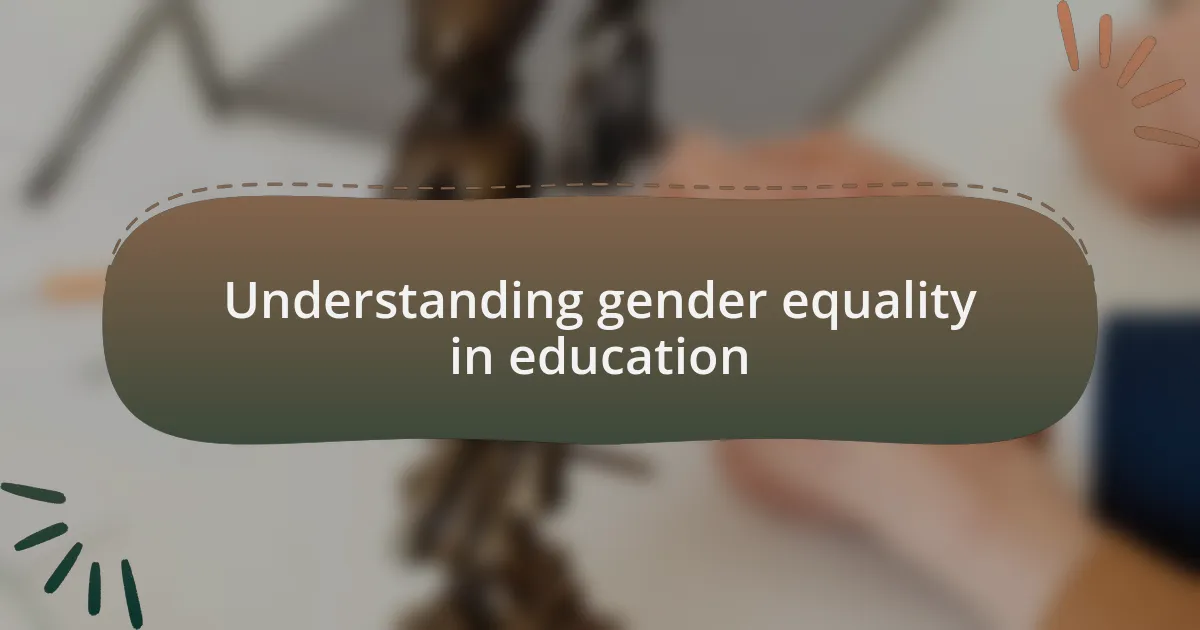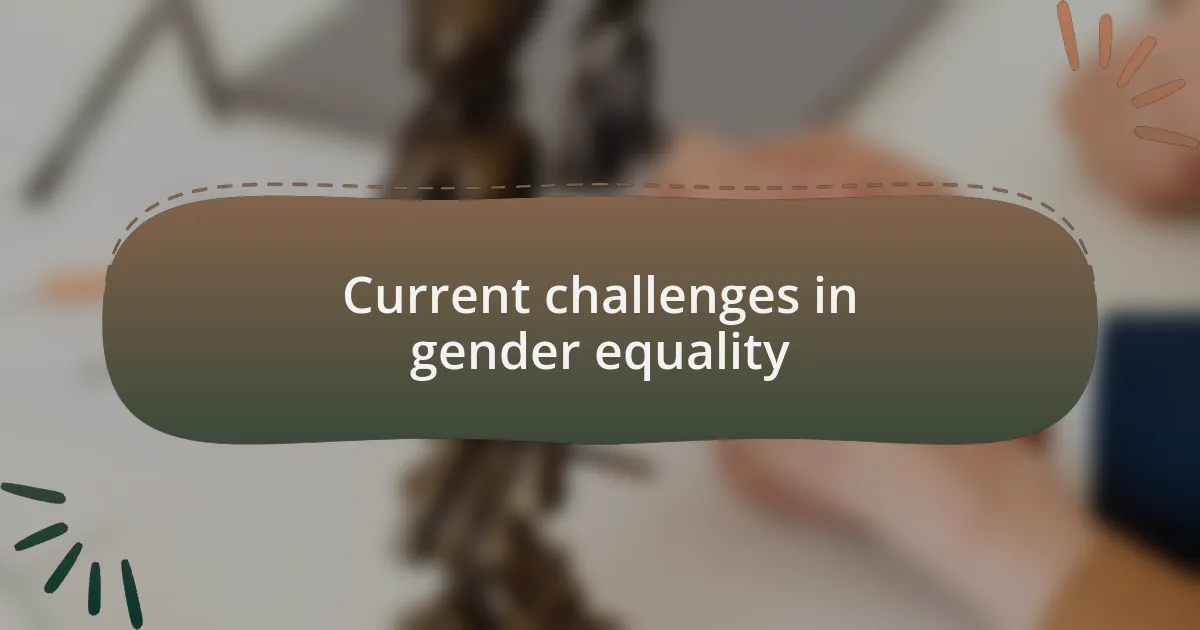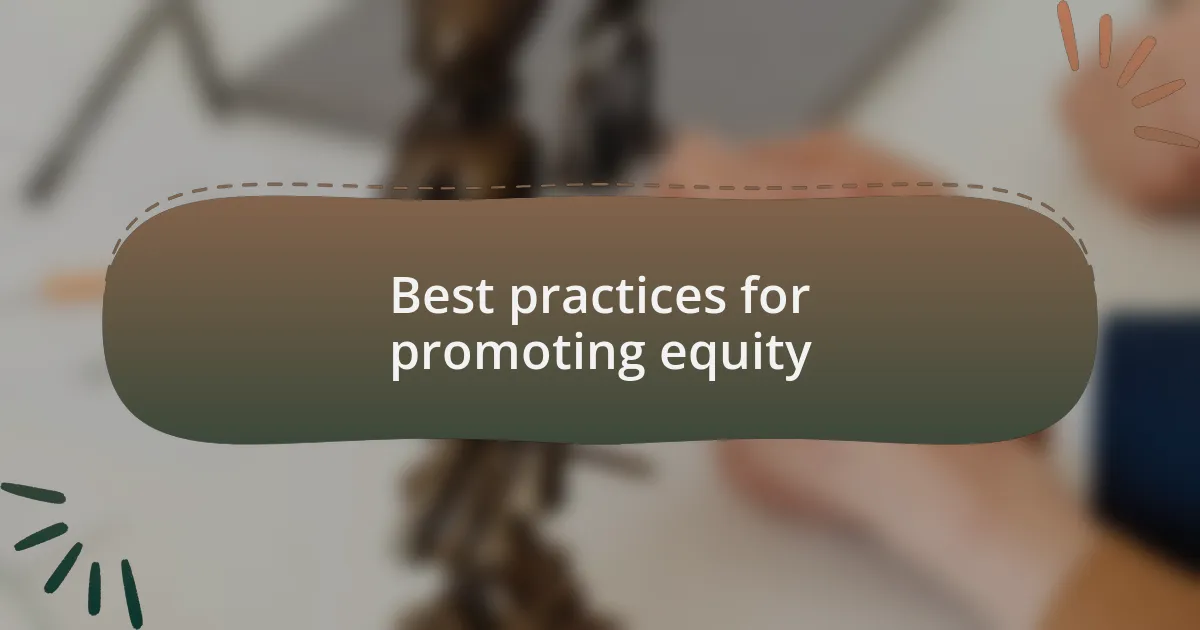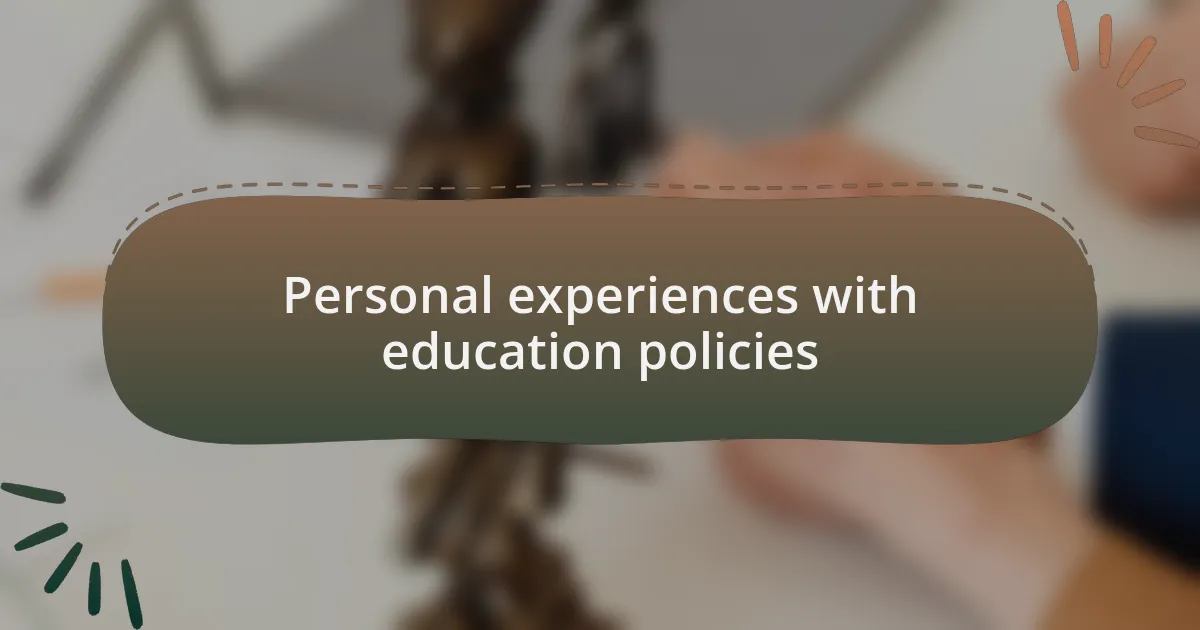Key takeaways:
- Gender equality in education goes beyond enrollment; it involves recognizing and nurturing all students’ talents regardless of gender.
- Persistent stereotypes and lack of representation among educators hinder girls’ confidence and aspirations in fields like STEM.
- Effective practices for promoting equity include diversifying curricula, ensuring resource equity, and fostering mentorship programs.
- Advocacy strategies such as building coalitions, using data to tell stories, and leveraging social media can drive significant change in educational policies.

Understanding gender equality in education
Gender equality in education is more than just balancing enrollment numbers; it’s about ensuring that all students have equal opportunities to thrive and learn. I recall visiting a local school where I met a young girl who excelled in math but felt discouraged because her talents were often overshadowed by boys in her class. How many potential innovators and leaders are we losing simply because we fail to recognize and nurture their abilities?
When we talk about gender equality, we often overlook the subtleties that affect learning experiences. One day, I attended a workshop where teachers shared their approaches to creating inclusive classrooms. It struck me how some educators were not just focusing on the curriculum but also questioning their biases—an essential step in fostering an environment where girls and boys can truly shine without limitation.
Equitable education policies are vital for dismantling stereotypes and creating safe spaces for dialogue. I remember discussing with a friend how she had to fight against the expectation that girls should settle for less in science classes. Isn’t it time we all ask ourselves how we can contribute to an education system that empowers every child, regardless of their gender?

Current challenges in gender equality
One of the significant challenges we face in advancing gender equality in education is the persistent stereotype that influences students’ aspirations. I remember a colleague sharing how her daughter wanted to pursue engineering, but peers suggested it wasn’t a “girl’s field.” How often do we limit our children’s dreams based on outdated notions? These stereotypes not only shape individual career paths but also perpetuate a cycle of underrepresentation in fields where women could thrive.
Another pressing issue is the lack of representation among educators. In my experience, when I attended a career fair, I noticed that the majority of role models for students were male, particularly in STEM subjects. This absence can affect girls’ confidence and willingness to pursue these disciplines. Isn’t it crucial to showcase diverse role models so that every child can see themselves in various roles and careers?
Moreover, socioeconomic factors play a crucial role in this equation. On a visit to a community center, I met a young boy whose mother worked multiple jobs, and he often missed school because of transportation issues. It made me reflect on how systemic inequalities can further complicate the conversation about gender. Shouldn’t we address these barriers to ensure that both girls and boys, regardless of their circumstances, have equitable access to quality education?

Best practices for promoting equity
One effective practice for promoting equity in education is actively diversifying curricula to include perspectives from various genders and cultures. I recall a workshop where educators collaborated to update the reading list to feature female authors alongside their male counterparts. Seeing students engage with stories that represented a broader spectrum of experiences sparked rich conversations. It made me wonder: how often do we miss opportunities to inspire students by broadening their literary landscapes?
Another key approach is ensuring equitable resource distribution in schools, especially in underserved areas. While volunteering at a local school, I witnessed firsthand the stark contrast in resources between my previous institution and that poorly funded one. I felt a surge of frustration realizing that students’ educational experiences were being hampered by such disparities. Why should access to quality education depend on zip codes?
Finally, fostering mentorship programs that connect young students with professionals can create pathways to success. I once participated in a mentorship initiative where we paired girls interested in technology with women already making strides in the field. The look of inspiration on their faces told me that these connections were more than just networking—they were about building futures. Isn’t it our responsibility to empower the next generation to envision and pursue their dreams?

Personal experiences with education policies
Reflecting on education policies, I can’t help but recall my own journey through school systems that emphasized standardized testing. While intended to measure academic performance, these tests often reduced learning to metrics, leaving little room for creativity. I remember sitting in exam rooms, feeling the weight of expectations as my thoughts raced—was my worth truly defined by a number on a paper?
Another vivid experience was during a community discussion on inclusivity. I shared my challenges in navigating a predominantly male-dominated academic field. The listening faces of teachers and fellow students reminded me of the power of shared stories. It felt invigorating to voice how representation—or the lack thereof—shapes our educational journeys. Does anyone else feel that their voice sometimes gets lost in the crowd?
Additionally, I often think about my high school’s push for college prep courses. While they were meant to help us succeed, many resources went to a small group of students, leaving others feeling overlooked. I can’t forget the frustration of friends who had dreams but were denied access based on their perceived capabilities. How many futures are still waiting for a chance simply because the system overlooks their potential?

Strategies for effective advocacy
When advocating for equitable education policies, one effective strategy involves building coalitions with diverse stakeholders. I recall a time when I joined forces with parents, teachers, and community leaders to lobby for resources for underfunded schools. This united front not only amplified our message but also fostered a sense of community ownership. Have you ever considered how powerful it is when voices come together for a common cause?
Another approach I found impactful is leveraging data to tell compelling stories. During a presentation, I showcased statistics on the disparities in funding and outcomes between schools in affluent areas versus those in marginalized regions. This data didn’t just highlight a problem; it resonated emotionally with people, prompting them to engage. Have you ever realized that numbers alone can evoke such passion if paired with personal stories?
Lastly, utilizing social media platforms for advocacy can extend reach exponentially. One of my most memorable experiences was launching a campaign that shared student testimonials about their struggles due to inadequate educational resources. The outpouring of support and conversation on various platforms was overwhelming. Have you witnessed how a simple post can create a ripple effect, igniting action and awareness?